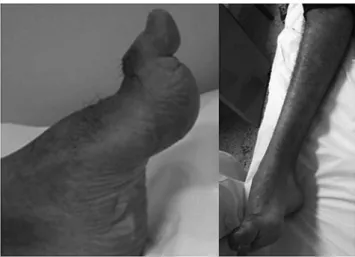170
DOI:
10.1590/0004-282X20130215
IMAGES IN NEUROLOGY
Tethered cord syndrome resembling
Charcot-Marie-Tooth disease in closed spinal
dysraphism
Síndrome da medula ancorada mimetizando doença de Charcot-Marie-Tooth no
disrafismo oculto da coluna
Paulo Victor Sgobbi de Souza; José Luiz Pedroso; Wladimir Bocca Vieira de Rezende Pinto; Orlando G. P.
Barsottini; Acary Souza B. Oliveira
A 23-year-old man presented with progressive dii
-culty walking since childhood. Examination showed pes
cavus, hammer toes, and peroneal atrophy (Figure 1).
Electroneuromyography revealed chronic denervation with
an axonal pattern, and Charcot-Marie-Tooth disease was
suspected. Urinary retention had started 3 years
previous-ly. Spinal cord magnetic resonance imaging (MRI) showed a
lipomeningomyelocele at the lumbosacral region with
spi-nal cord tethering (Figure 2). he skin of the lumbosacral
region was normal. Surgery was performed without imme
-diate improvement.
Tethered cord syndrome due to occult spinal cord
dys-raphism is a diverse clinical entity, and cutaneous manifes
-tations may be absent. Pes cavus and hammer toes are rare
but can be present and strongly resemble
Charcot-Marie-Tooth disease
1-3. he emergence of urinary symptoms is a
hallmark for the diagnosis of cauda equina syndrome in
-stead of neuropathy.
Department of Neurology, Universidade Federal de São Paulo, Sao Paulo SP, Brazil.
Correspondence: José Luiz Pedroso. Rua Botucatu, 740, Vila Clementino, CEP: 04023-900 São Paulo SP, Brasil. E-mail: jlpedroso.neuro@gmail.com Conflict of interest: There is no conflict of interest to declare.
Received 23 May 2013; Received in final form 16 August 2013; Accepted 23 August 2013.
Figure 1.
Note pes cavus, hammer toes, and peroneal atrophy,
resembling features observed in Charcot-Marie-Tooth disease.
171
Paulo Victor Sgobbi de Souza et al. Tethered Cord syndromeReferences
1. Lew SM, Kothbauer KF. Tethered cord syndrome: an update review. Pediatr Neurosurg 2007;43:236-248.
2. Hertzler DA II, DePowell JJ, Stevenson CB, Mangano FT. Tethered cord syndrome: a review of the literature from embryology to adult presentation. Neurosurg Focus 2010;29:E1.
